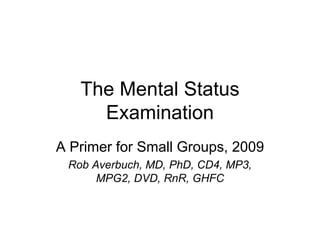
The mental status_exam_hb_09
- 1. The Mental Status Examination A Primer for Small Groups, 2009 Rob Averbuch, MD, PhD, CD4, MP3, MPG2, DVD, RnR, GHFC
- 2. What is the Mental Status Examination? • Sum total of observations made during a psychiatric interview via: – Direct Inquiry about subjective symptoms – Objective findings (signs)
- 3. Why is it the Mental Status Exam so Important? • Almost all psychiatric diagnoses are made, at least in part, clinically – i.e. from taking a history, making observations during the interview, etc. – Not solely from laboratory values, virology reports, or imaging studies – Thus, greater emphasis on direct observations of patient
- 4. Mental Status Examination • Can be divided into 2 sections: – 1. Observational Data • Most areas assessed while taking a history – 2. Formal Cognitive Testing: MMSE (Mini-Mental State Exam), etc.
- 5. What You’ll Want to Observe: • Appearance • Behavior – Cooperation/ Attitude • Speech • Thought Process/Form • Thought Content
- 6. What You’ll Want to Observe: • Perceptions • Mood and Affect • Insight and Judgment • Cognitive Functioning and Sensorium
- 7. Appearance • Attire • Hygiene and Grooming – “Disheveled”- ruffled appearance – “Unkempt”- poor attention to grooming
- 8. Appearance • Body habitus, nourishment status – General description of body type/ build, and nutritional status
- 9. Behavior- Movements • Range and Frequency of Spontaneous Movements – Psychomotor activity – Abnormal movements
- 10. Psychomotor Activity • Psychomotor refers to movements that appear driven from within, by one’s internal emotions at the time – Psychomotor Agitation, vs. – Psychomotor Retardation
- 11. Psychomotor Agitation defined • Physical restlessness, usually with a heightened sense of tension and increased arousal • Results from emotions such as anxiety, anger, and confusion • Common Signs include: hand-wringing, fidgeting, frequent shifts in posture, foot- tapping
- 12. Psychomotor Retardation • An overall slowness of voluntary and involuntary movements – Results from emotions such as apathy, depression, etc.
- 13. Abnormal Movements • Mannerisms: goal-directed, complex behaviors carried out in an odd way or inappropriate context
- 14. Abnormal Movements • Tardive Dyskinesia (TD)- involuntary choreoathetoid movements of delayed onset, resulting from long-term antipsychotic use • Primarily seen in peri-oral region: mouth, lips, tongue, face
- 15. Disorganized Behavior • Seemingly purposeless, random, non- goal directed, often complex behaviors (may include mannerisms) – Ex. Disrobing in public, urinating on oneself, dancing, posturing, etc.
- 16. Cooperation/ Attitude • Attitude/Relatedness • Eye contact • Level of Alertness/ Attentiveness – Easily distracted – Hypervigilant (constantly scanning the environment)
- 17. Qualities of Speech • Quantity/Amount – Too much – Too little – None = mutism (absence of speech)
- 18. Qualities of Speech • Articulation- clarity with which words are spoken – dysarthric (poorly articulated speech)
- 19. Qualities of Speech • Rate – Slowed/halting vs. Normal vs. Rapid
- 20. Speech Rate • “Pressured”: increased rate (and amount); driven to keep talking; uninterruptible
- 21. Disorganized Speech • Speech that is lacking in meaning and/or inappropriate for the context • Usually reflective of an underlying “disorganized thought process”
- 22. Prosody • The emotional valence/intonations of speech; adds emphasis, maintains listener’s interest • Speech lacking in Prosody is monotone and boring
- 24. Thought Process/ Form • How ideas are put together, organized, and ultimately produced (as speech) • Assessed via speech, writing, and behavior
- 25. Normal Variants or Pathological? • Circumstantiality- overly detailed; over-inclusive; but eventually gets to the point • Tangentiality- starts out in general vicinity of goal /target, but never reaches the end point
- 26. Abnormalities: Idiosyncracies • Idiosyncracies: Private use of words, language; illogical; understanding is unique to the patient; irrational
- 27. Abnormal Thought Processes: Flight of Ideas • Ideas are linked by primitive associations such as rhyming, and punning • Has a rapid quality • Often with a sensation of “racing thoughts”
- 28. Looseness of Associations • Looseness of Associations- Ideas only obliquely related, if at all • In its extreme form there is a loss of any meaningful connections between ideas and it’s unclear how someone decides to go from one topic to the next
- 29. Thought Content
- 30. Thought Content (TC) • Refers to predominant themes, preoccupations the person has • For our purposes, it’s usually about making sure they don’t have abnormal thoughts
- 31. Normal vs. Abnormal TC • Normal = absence of abnormalities • Abnormal: – Delusions – Obsessions – Suicidal /Homicidal Ideations
- 32. What’s a Delusion? • Fixed false (untrue) belief, not culturally sanctioned (not just unique, but accepted in that person’s culture) – “Fixed” means they’re 100% convinced it’s true- ie, good luck trying to convince them otherwise • Range from implausible (unlikely but non-bizarre) to impossible (bizarre)
- 33. Perceptual Abnormalities • Illusions • Hallucinations
- 34. Illusions • Misperceptions of external stimuli – There’s something there, but the person is misinterpreting it as something else – Ex. a chair may look like a person to someone who is delirious
- 35. Hallucinations • False sensations in the absence of external stimuli (ie. Anything real)
- 36. Mood and Affect How they describe emotional state vs. what you see
- 37. Mood • Mood: internal feeling state – It’s subjective – Ex. “happy”, “angry”, “nervous”, “fine”
- 38. Affect • Observable, external expression of emotional tone – It’s objective
- 39. Insight and Judgment • Insight- understanding and appreciation of current situation, illness • Judgment- ability to make sound decisions; best assessed via recent history
- 40. The End